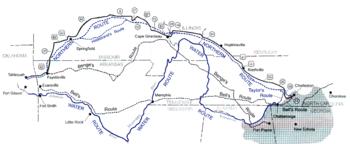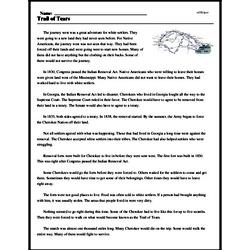Trail of Tears
The journey west was a great adventure for white settlers. They were going to a new land they had never seen before. For Native Americans, the journey west was not seen that way. They had been forced off their lands and were going west to start new homes. Many of them did not have anything but the clothing on their backs. Some of them would not survive the journey.
In 1830, Congress passed the Indian Removal Act. Native Americans who were willing to leave their homes were given land west of the Mississippi. Many Native Americans did not want to leave their homes. They had worked hard to live with white settlers.
In Georgia, the Indian Removal Act led to disaster. Cherokees who lived in Georgia fought all the way to the Supreme Court. The Supreme Court ruled in their favor. The Cherokee would have to agree to be removed from their land in a treaty. The Senate would also have to agree to a treaty.
In 1835, both sides agreed to a treaty. In 1838, the removal started. By the summer, the Army began to force the Cherokee Nation off their land.
Not all settlers agreed with what was happening. Those that had lived in Georgia a long time were against the removal. The Cherokee accepted white settlers into their tribes. The Cherokee had also helped settlers who were struggling.
Removal forts were built for Cherokee to live in before they were sent west. The first fort was built in 1830. This was right after Congress passed the Indian Removal Act.
Some Cherokees would go the forts before they were forced to. Others waited for the soldiers to come and get them. Sometimes they would have time to get some of their belongings. Other times they would have to leave right away.
The forts were not good places to live. Food was often sold to white settlers. If a person had brought anything with him, it was usually stolen. The areas that people lived in were very dirty.




